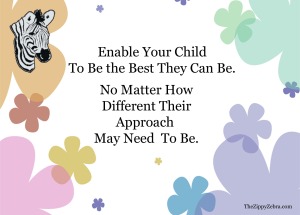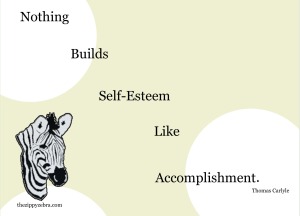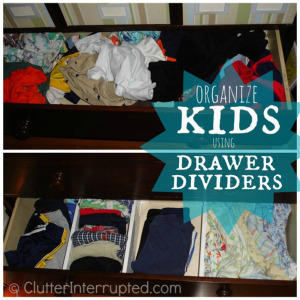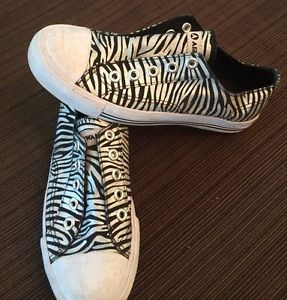12 Adaptations For Your Physically Challenged Child
We have covered most of the school spoonsavers, mobility spoonsavers and at-home for school spoonsavers in previous posts.
These 12 “spoonsavers” are things we have done for our children at one time or another in order to reduce the amount of stress and pain in ALL of our lives.
A child who can accomplish things on their own is a child with a healthier esteem.
Even if that means making some small adjustments to what society says is “normal”.
I, personally, could go insane trying to help my girls dress, eat and live their daily lives.
Since I struggle with EDS too I try to find adaptations “spoonsavers” to encourage them to be independent and allow me to keep what little mind I have left intact.
12 More Adptations For Your Physically Challenged Child
Please keep in mind not all of these may apply to your child or household.
1.Lower your child’s closet rod.
(Photo from ClosetInterrupted)
If your child is old enough to pick out their everyday clothes and hang them up but the rod is too high, lower it or build one.
This will give them a sense of independence and free up your time.
Even if your child is tall enough to reach a high rod some injuries may prevent them from reaching above their heads, A lower rod will help with this. (When my children were small we simply added a second rod below and stored our out of season, grow-into and special occasion items above.)
2.) Put the clothes they wear the most in easy to reach drawers as organized as possible.
(Photo from ClosetInterrupted)
When your child wakes in the morning he/she maybe in pain just from their illness not including any injuries. Being able to locate and grab socks, unmentionables, tanks, etc… without bending or digging can result in a much happier, better prepared child.
Since my two daughters began sharing a room (they can’t travel the stairs every night) we have actually began putting my youngest daughter’s folded items in baskets in her closet.
This reduces back pain and gives me a break because they can still manage to grab their own clothes with one hand most days.
Closet photos from Clutterinterrupted.com click here or on each photo for more great ideas.
3.) Buy clothes that are easy to put on.
Buy clothes with easy snaps, zips, buttons or with no closures at all.
I don’t know how many times my daughters have been in tears because they couldn’t dress themselves.
Pretty buttons are great but not at 7:00 am when they keep dislocating their fingers trying to fasten their jeans.
4.) Keep clothes on hand that are stretchy and slightly larger than your child wears.
These will be used to slip over casts, slings, braces and swollen areas.
Our favorites are cool sweats and pj’s for leg casts and braces.
(Dislocating a shoulder and wrist while trying to tug jeans on is NO fun.)
We grab cute ones at thrift stores and resale shops when they are marked down.
Button up shirts are great for elbow and arm casts.
5.) Keep braces, slings, ace wraps, etc… in a portable, breathable bag for quick, on the go access.
This enables you to find them as needed without searching your home, car, grandma’s, etc…
It is also portable so when the school calls or she/he falls at a friends you can get him/her stabilized and on with their day.
6.) Keep a “Doctor visit/hospital” bag packed.
We have all been there. Hours at the ER or doctor’s waiting room while your child grows more and more miserable and agitated.
If you are like us the “good” hospital is at least an hour away and you need to get there and back with the sanity you have left.
For these trips keep a “to-go” bag packed (see list on photo above).
7.) Buy non-slick, supportive easy on & off shoes
Not too heavy to move in but sturdy enough to support their feet.
All children should try to learn to tie but when their arm is in a sling or cast the task is almost impossible.
8.) Keep a journal/binder
The above is the list we use to give you an idea of what might be useful.
9.) Set up an easy access snack area so your child can grab their own snacks and drinks.
Keep snacks in prepacked baggies and containers. Nothing frustrates my family more than trying to get their own food or drink and spilling the entire bag on the floor. If it is in a smaller container it is easier to handle and creates less of a mess if we do drop it.
We use these containers from Dollar Tree for nuts, m&m’s, cereal, etc….
They are great because they are only $1 for 8-10/pkg.
Transfer drinks to smaller, easy to handle containers for little hands to pour or make pre-made sippy cups.
10.) Place plastic cups, plates and bowls within easy reach of your child.
This reduces the need to stretch, strain or bend and should reduce the amount of dropping and breakage.
Besides plastic weighs less and is easier to hold.
11.) Keep extra large socks or house shoes on hand to slip over casts in cold weather or for trips to the car.
Tip: This is a great way to use all the odd mates you find after the dryer eats them.
12.) Dress your child in layers (especially for doctor appointments)
Tank tops are great!
Very often they will be allowed to leave them on during examinations.
It makes your child feel less exposed and generally more comfortable to share their concerns with the staff (and you).
If you have found this list helpful or have anything to add please do so in the comments below.
Other links in the series “Helping Your EDS Child” include:
How do you prepare for an IEP or 504?
How To Help Your EDS Child At Home
Transportation and Mobility Ideas for Your Child
Follow us on Pinterest, Twitter, Facebook and sign up to receive emails.
Feel free to share this and any other post with your social media and don’t forget to drop a line of encouragement.
I can always use one.
Thanks for stopping by and have a great day!
#enablingyouredschild #yourEDSchild #EDS #spoonsavers
















